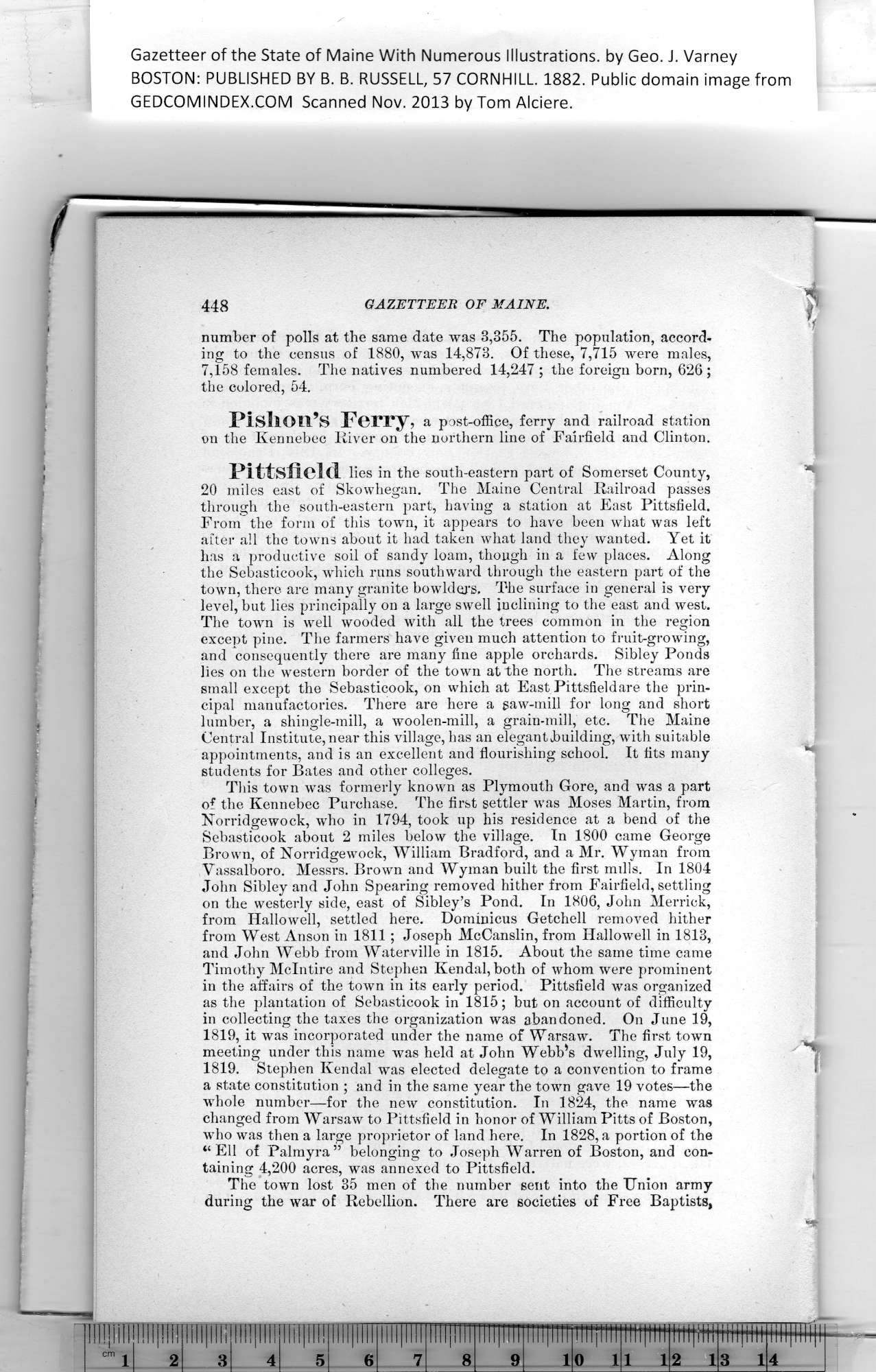|
Gazetteer of the State of Maine With Numerous Illustrations, by Geo. J. Varney
BOSTON: PUBLISHED BY B. B. RUSSELL, 57 CORNHILL. 1882. Public domain image from
448 GAZETTEER OF MAINE.
number of polls at the same date was 3,355. The population, accord-
ing to the census of 1880, was 14,873. Of these, 7,715 were males,
7,158 females. The natives numbered 14,247 ; the foreign born, 626 ;
the colored, 54.
Pislion’s Ferry, a post-office, ferry and railroad station
on the Kennebec River on the northern line of Fairfield and Clinton.
Pittsfield lies in the south-eastern part of Somerset County,
20 miles east of Skowhegan. The Maine Central Railroad passes
through the south-eastern part, having a station at East Pittsfield.
From the form of this town, it appears to have been what was left
after all the towns about it had taken what land they wanted. Yet it
has a productive soil of sandy loam, though in a few places. Along
the Sebastieook, which runs southward through the eastern part of the
town, there are many granite bowlders. The surface in general is very
level, but lies principally on a large swell inclining to the east and west.
The town is well wooded with all the trees common in the region
except pine. The farmers have given much attention to fruit-growing,
and consequently there are many fine apple orchards. Sibley Ponds
lies on the western border of the town at the north. The streams are
small except the Sebastieook, on which at East Pittsfield are the prin-
cipal manufactories. There are here a gaw-mill for long and short
lumber, a shingle-mill, a woolen-mill, a grain-mill, etc. The Maine
Central Institute, near this village, has an elegant building, with suitable
appointments, and is an excellent and flourishing school. It fits many
students for Bates and other colleges.
This town was formerly known as Plymouth Gore, and was a part
of the Kennebec Purchase. The first settler was Moses Martin, from
Norridgewock, who in 1794, took up his residence at a bend of the
Sebastieook about 2 miles below the village. In 1800 came George
Brown, of Norridgewock, William Bradford, and a Mr. Wyman from
Vassalboro. Messrs. Brown and Wyman built the first mills. In 1804
John Sibley and John Spearing removed hither from Fairfield, settling
on the westerly side, east of Sibley’s Pond. In 1806, John Merrick,
from Hallowell, settled here. Dominions Getchell removed hither
from West Anson in 1811 ; Joseph McCanslin, from Hallowell in 1813,
and John Webb from Waterville in 1815. About the same time came
Timothy Mclntire and Stephen Kendal, both of whom were prominent
in the affairs of the town in its early period. Pittsfield was organized
as the plantation of Sebastieook in 1815; but on account of difficulty
in collecting the taxes the organization was abandoned. On June 19,
1819, it was incorporated under the name of Warsaw. The first town
meeting under this name was held at John Webb’s dwelling, July 19,
1819. Stephen Kendal was elected delegate to a convention to frame
a state constitution ; and in the same year the town gave 19 votes—tbe
whole number—for the new constitution. In 1824, the name was
changed from Warsaw to Pittsfield in honor of William Pitts of Boston,
who was then a large proprietor of land here. In 1828, a portion of the
“Ell of Palmyra” belonging to Joseph Warren of Boston, and con-
taining 4,200 acres, was annexed to Pittsfield.
The town lost 35 men of the number sent into the Union army
during the war of Rebellion. There are societies of Free Baptists,
PREVIOUS PAGE ... NEXT PAGE
This page was written in HTML using a program written in Python 3.2
|
